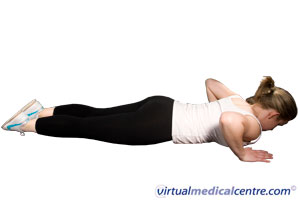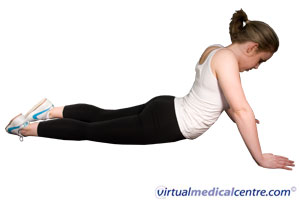- What is Lower Back Pain?
- Statistics
- Risk Factors
- Progression
- Symptoms
- Clinical Examination
- How is it Diagnosed
- Prognosis
- Treatment
- References
What is Lower Back Pain?
The lower back is a complex structure composed of the vertebrae (the back bones), the nerves which leave the spinal cord at that level, ligaments, muscles and other soft tissues. The back provides support, movement and protects important structures such as the spinal cord. The vertebrae (the lumbar ones at that level) articulate with each other via the facet joints at the back, and are also separated from each other by a cushion, or shock absorber called the intervertebral disc. They are held together by various ligaments, and form the site of attachment of the back muscles. Nerves exit at the side of the backbone at every level.
Lower back pain means a back pain roughly between the bottom of the ribs and the top of the legs at the back. Importantly, the pain often radiates to the buttocks, and sometimes further down the leg and even to the foot. When back pain is combined with pain into the leg, travelling down below the knee, it is referred to as sciatica, because the nerve roots of the sciatic nerve at the back are being irritated by pressure on it.
There are many mechanisms of back pain, but the most common one is called ‘mechanical’ back pain or vertebral dysfunction. Vertebral dysfunction occurs due to malalignment between the lumbar vertebrae at the facet joints and/or intervertebral discs. The small degrees of disarticulation are not gross enough to be seen on an x-ray but cause painful muscle spasms and sometimes nerve impingements which contribute to symptoms.
Statistics
Approximately 80% of individuals will experience an episode of lower back pain at some time during their life. Lower back pain is the fifth leading reason for patients visiting a doctor and the leading cause of work-related disability. However, the underlying cause is usually not serious and may not even be identified by the doctor.
Lower back pain is most common in patients between the ages of 20 and 40 years but can be more severe and disabling in elderly patients. Fortunately however, the majority of patients suffering back pain will recover and only 5% go on to develop a chronic condition. Back pain is associalted with huge economic costs through medical expenditure and loss of worker productivity.
Adults
Men and women are equally affected by lower back pain but the underlying causes of the pain may differ. For example, women suffer back pain during pregnancy and menstruation or from conditions such as osteoporosis f(bone thinning) or osteoarthritis (joint destruction) which are correspondingly more common in females. Men may be more likely to suffer lower back pain secondary to trauma from sporting or labour-intensive work activities.
The point prevalence of lower back pain in men and women is approximately 5%. The onset of pain is most common between the ages of 30 and 50 years in both men and women.
Children
Lower back pain is not common in children and when present is more likely to represent a serious underlying pathology such as maliganancy (cancer) or infection. All lower back pain in children should be considered seriously and medical advice should always be sought if the pain persists longer than a few days.
Risk Factors
There are many causes of low back pain, but they can be grouped roughly as follows:
- Trauma;
- Mechanical:
- Muscular pain;
- Vertebral dysfunction;
- Prolapsed disc (slipped disk);
- Narrowing of bony canals;
- Fibromyalgia: Generalised aches and pains;
- Incorrect bone positions and articulation;
- Inflammatory;
- Infective lesions of the spine;
- Ankylosing spondylitis/ sacroileitis;
- Metabolic:
- Osteoporosis, fracture particularly in elderly, post-menopausal women;
- Paget’s disease;
- Neoplastic (tumours/cancer):
- Metastases from tumours of other organs;
- Primary bone tumours;
- Multiple myeloma;
- Vascular: Disruption of the blood supply to the spinal cord (spinal claudication);
- Referred pain: Pain spreads to the back from somewhere else, for example to urinary tract. More common in elderly men;
- Depression.
A precise cause for the back pain is only identifiable in around 15% of cases.
Children
Back pain in children is more likely to have a serious cause. The following may be present:
- Developmental disorders: Arthritis of the spine (spondylolysis) or slipping of the vertebral bodies across one another (spondylolisthesis);
- Disc herniation (slipped disc);
- Scheuermann disease: Typically in adolescent males where there is weakening of the vertebral end-plates causing crushing and painless kyphosis (increased curvature of the back producing a ‘hunch’);
- Tumours of the bone or spinal cord;
- Infection of the discs (discitis) or bone (osteomyelitis) mostly in children less than 10 years old;
- Congenital disorders such as scoliosis (lateral curvature of the spine).
Progression
This depends on many factors. Defining a precise underlying cause is often difficult, this encourages multiple medical consultations with differrent doctors, which further compounds the problem. Periods of naturally occurring improvement and flare-ups are the rule regardless of the aetiology (cause or origin). This is especially true in lumbar disc disease and lumbosacral strain and sprain (represents most cases). The most significant factor in the outcome of low back pain is the duration of persistent symptoms. Less than 50% of patients who experience low back pain for over 6 months ever return to gainful employment.
How is it Diagnosed
Acute pain less than two weeks that is not sinister requires no investigations.
Screening tests (indicated in chronic back pain longer than 3 months):
- Plain x-rays;
- Urinalysis;
- ESR- a marker of inflammation;
- Alkaline phosphatase- a liver enzyme also produced by bone that may be elevated in bone resorptive diseases;
- Men: Prostatic specific antigen- a good marker for prostate cancer. Values must be compared to normal values for the man’s age group.
Prognosis
The prognosis is extremely variable, since it depends on the cause of the back pain. For cases due to vertebral dysfunction, disc disease or musculoligamentous strains the duration of symptoms is an indicator of how likely the pain is to persist.
Fortunately, the majority of cases of back pain are due to benign causes and most men and women will recover without any long-term deficits.
Treatment
History, examination and investigation should have provided your doctor sufficient information to devise an appropriate treatment plan. The management of back pain varies largely based on the underlying causes. Some possible treatment modalities are listed below but your doctor should advise which is suitable for you based on your circumstances.
For acute back strain caused by forward bending, the following exercise stretch may be helpful:
 |
 |
|
| Step 1: Lie on your stomach with your hands positioned next to your shoulders. | Step 2: Using your arm muscles, straighten at your elbows and slowly raise your torso off the ground. Ensure you do not use your back muscles, throw your head back, or lift your pelvis from the floor. Repeat this twenty times in a row or as pain allows. |
- Back education: Your doctor will explain how you can better care for your spine and prevent further injury;
- Analgesics such as paracetamol or aspirin are commonly used. Courses of anti-inflammatopry drugs are often prescribed but these can have significant side-effects and are not suitable in patients with peptic ulcers or bleeding problems. Stronger analgesics (narcotics) may be used in cases of acute lower back pain;
- Activity modification: Initially some bed rest is prescribed for certain conditions but exercise is often encouraged later to prevent deconditioning. Your doctor will also advise you which activities and movements you should avoid to prevent further damage;
- Physical therapy: Superficial heat, ultrasound, cold packs and massage are useful for relieving symptoms in the acute phase but should be used only on doctor’s advice;
- Corsets: Their use remains controversial and are only used in men with compression fractures to stabilise the spine;
- Chiropractic manipulation can help in some patients but the long term benefit has not yet been demonstrated in studies;
- Psychological counselling: Your doctor may talk to you about depression and poor job satisfaction which may be contributing to the pain;
- Surgery is suitable for a handfull of patients. Patients with suspected cauda equina lesions (characterised by saddle anesthesia, sensorimotor changes in the legs and urinary retention) and those with worsening neurologic deficits should undergo surgical evaluation.
Children
Successful treatment in children relies on early and accurate diagnosis. Some general treatment principals are listed:
- Overuse injury and development abnormalities should be treated with rest and analgesia (pain relief);
- Antibiotics will be needed in cases of infection and should be prescribed based on suspicion of the condition;
- Surgery in combination with chemotherapy or radiotherapy will be needed for malignant tumours;
- Simple analgesics such as acetaminophen and ibuprofen are used in most patients. Juvenile rheumatoid arthritis may require disease-modifying agents such as methotrexate but careful monitoring for side-effects is required.
References
- Bogduk N. Management of chronic low back pain. Med J Aust. 2004;180(2):79-83. [Abstract | Full text]
- Kumar P, Clark M (eds). Clinical Medicine (5th edition). Edinburgh: WB Saunders Company; 2002. [Book]
- Wheeler SG, Wipf JE, Staiger TO, Deya RA. Approach to the diagnosis and evaluation of low back pain in adults [online]. Waltham, MA: UpToDate; 2006 [cited 21 February 2006]. Available from: URL link
- Chou R. Low back pain [online]. Waltham, MA: UpToDate; 2006 [cited 21 February 2006]. Available from: URL link
- Murtagh J. General Practice (2nd edition). New York: McGraw-Hill; 1998. [Book]
- Patel AT, Ogle AA. Diagnosis and management of acute low back pain. Am Fam Physician. 2000;61(6):1779-86, 1789-90. [Abstract | Full text]
- Perina DG. Back pain, mechanical [online]. Omaha, NE: WebMD eMedicine; 2006 [cited 1 April 2006]. Available from: URL link
- McKenzie R. Treat Your Own Back: How to safely, simply and scientifically relieve your own back pain. Waikanae, NZ: Spinal Publications; 1981. [Book]
All content and media on the HealthEngine Blog is created and published online for informational purposes only. It is not intended to be a substitute for professional medical advice and should not be relied on as health or personal advice. Always seek the guidance of your doctor or other qualified health professional with any questions you may have regarding your health or a medical condition. Never disregard the advice of a medical professional, or delay in seeking it because of something you have read on this Website. If you think you may have a medical emergency, call your doctor, go to the nearest hospital emergency department, or call the emergency services immediately.







